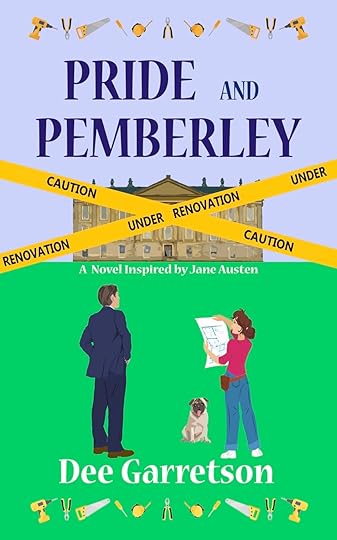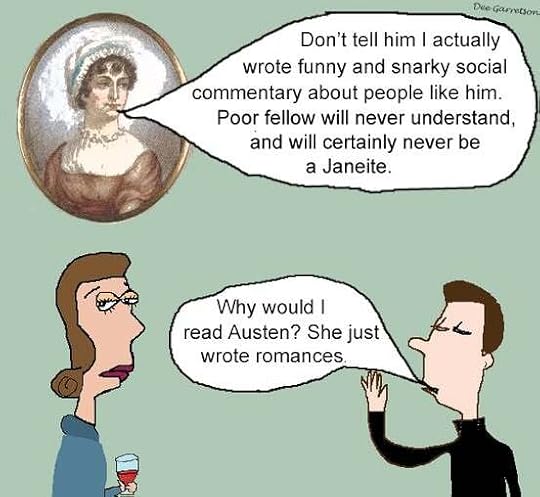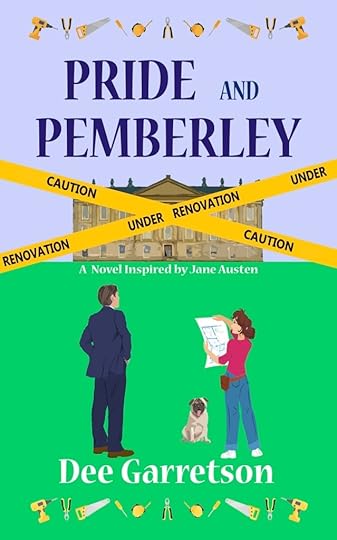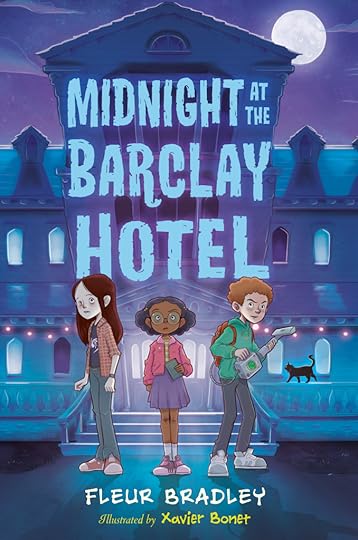Dee Garretson's Blog
June 24, 2025
The Best Order To Read Jane Austen’s Books So You Fall In Love With Them And Her

If you get a group of Jane Austen fans together, they will ever so politely debate the order in which the books should be read. There were only six full length completed novels, so It’s a manageable discussion. I’m always trying to recruit readers to become Janeites so I think the order is important to get newbies to fully embrace Austen. I also think the order matters if you start reading the books as a teenager versus an adult. I’d switch them around a bit depending on the age of the reader. I’ve done rankings for both, but in this post I’ll just give my thoughts on the list for getting into Jane Austen as an adult.
The basic list:
PRIDE AND PREJUDICE
SENSE AND SENSIBILITY
MANSFIELD PARK
EMMA
NORTHANGER ABBEY
PERSUASION
Here’s why:
PRIDE AND PREJUDICE – This is the most popular book, probably because the humor is apparent within the first few pages, and the main character, Elizabeth Bennet, is very relatable to people today. She’s lively and intelligent, but doesn’t have overwhelming beauty, accomplishments, or wealth. I think that makes it easy for readers to identify with her. And while Mr. Darcy is too snobbish for my tastes, It is enjoyable to see him realize his snobbishness is overbearing by the end of the book.
SENSE AND SENSIBILITY – Here Austen gives up two contrasting characters, Elinor and her sister Marianne. Their personalities are wildly different and again, it makes it easy for readers to identify with one or the other or somewhere in between. The family’s situation is so unfair that the reader roots for them to overcome it. Their selfish brother and his wife are easy to dislike, which does make for a good story, though they aren’t the main villains. There are humorous characters as well, so that adds an extra appeal. The men don’t come across too well in this book, except for Colonel Brandon, but that is true of basically all Jane Austen’s books. In my mind, she doesn’t ever write the most appealing love interests except for one (more about that later), so it’s the story and the women characters and the social situations that are most interesting to read.
MANSFIELD PARK – I have a fondness for this story though many readers find the main character of Fanny Price too meek. She’s such an underdog though, and in such a precarious position, I think it’s appealing that she eventually learns to speak up and remain firm in her principles. If you enjoyed THE SECRET GARDEN or THE LITTLE PRINCESS as a child, Fanny Price should appeal to you.
EMMA – I have to admit Emma is my least favorite Austen. I don’t find as much humor in this story as I do the others. Emma is quite a self-assured character for the time period, both wealthy and of what was considered ‘good’ family. She’s a bit clueless about other people’s feelings though she likes to meddle in people’s lives. If you’ve seen the movie Clueless, a modern day teenage version of Emma, there’s a reason they gave it that name. The main reason I don’t like Emma is because the love interest, Mr. Knightly, is so overbearing and so sure of his superiority over Emma. I find him extremely annoying. Many people love this book though, so it definitely should be read.
NORTHANGER ABBEY – This book is a fun read, though the characters aren’t as well drawn as in some of Austen’s other books. It makes more sense to read when you know that women of the time were fascinated by gothic novels full of sinister characters and mysterious houses.
PERSUASION – This is my favorite Austen novel, though not when I first read it. It’s much better appreciated by older readers. The main character herself is a bit older than those in some of her other novels, and has had more disappointments in life. She’s dealing with difficult relatives, and she’s made some bad choices in the past. I do like the love interest, Captain Wentworth. He is not as dashing as Mr. Darcy, but he is steadfast and thoughtful. The book itself is one that reads to me as the most traditional romance of Austen’s works, and if you want to write romance, it’s a good book to study how it should be done.
So that’s my list. I’d love to hear your thoughts.
And I have to end with a boost for my own Austen-inspired contemporary romcom, PRIDE AND PEMBERLEY. What if Jane Austen’s characters had descendants living today? A single woman in possession of a crumbling mansion needs more than pride to keep it from falling down. Available as an ebook, paperback, and in Kindle Unlimited. Hardcover and large print editions coming soon.

June 12, 2025
Garden flowers in the time of Jane Austen, First up: Spiderwort

Back when I was studying and then teaching and working as a landscape designer, I became very interested in historic gardens. When I was writing PRIDE AND PEMBERLEY, I researched restoring old houses and the renovation of listed properties, meaning those of historic interest, in England. But not only the houses are categorized as listed properties. Certain gardens are as well, and must be planted according to guidelines to keep them looking somewhat as they did in the past. That means a careful choice of plants.
This picture is of all the various flower colors of spiderwort, which hybridizes freely in my somewhat chaotic garden, and a plant that certainly would have been in the gardens of the upper classes during Jane Austen’s time. Its scientific name is Tradescantia virginiana, and it was brought to England by John Tradescant the Younger on one of his collecting trips to the Americas. Tradescant and his father were botanists and gardeners for King Charles the 1st.
Transporting plants from one place to another is now something we undertake with care, or we should, because non-native plants can overtake and smother out native plants in certain environments. Back in the 17th, 18th and 19th century people were mad for new plants from all over the world and I’m sure spiderwort’s lovely blue flowers were in great demand in England, even though it is not suitable as a cut flower. It closes later in the day and has a sap that can irritate some people’s skin.
It’s fun to speculate what plants would have been in the gardens of Roslings and Pemberley, two of the large estates mentioned in PRIDE AND PREJUDICE. A piece of dialogue that has always stuck in my head and instantly shows a distinction between classes in Pride and Prejudice is Lady Catherine de Bourgh’s snide remark about the Bennet’s garden. “You have a very small park here,” returned Lady Catherine after a short silence.
“It is nothing in comparison of Rosings, my lady, I dare say; but I assure you it is much larger than Sir William Lucas’s.” (Mrs. Bennet’s reply to show their family ranks below Lady Catherine but above the Lucases in some ways.)
Ah, for the days when people could have live-in gardeners. At my house, that’s me and my husband. I wish I could pass out small spiderworts to everyone who wanted one, because I’ve got so many they are practically weeds in our yard. If you do get ahold of one, plant in either a partly shady or sunny area. The ones in the shade are leggier than those in sunny spots. They bloom here in Ohio from May through June, and then if you cut them back, watching out for the sap, they’ll put on new growth and rebloom in the fall.

June 10, 2025
Why Read Jane Austen?

I’m indulging in all things Jane Austen in this 250th anniversary of her birth. Why read her?
Jane Austen was a keen observer of the absurdities of human interaction. That’s what makes her books humorous. She must have met her fair share of buffoons, snobs, blockheads and dullards to portray them so accurately in her stories. But she didn’t need to label them for her readers. Her dialogue gave such life to her characters that you can imagine being in the room watching these people with Elizabeth Bennet and sharing the same thoughts on them as she did. Once you’ve read about Lady Catherine de Bourgh in PRIDE AND PREJUDICE you cannot forgot her. These few lines sum her arrogance perfectly: “There are few people in England, I suppose, who have more true enjoyment of music than myself, or a better natural taste. If I had ever learnt, I should have been a great proficient.”
The fact that Jane Austen wrote the books more than two hundred years ago and they are still beloved today show that people don’t change much. We readers can recognize someone we know in her panoply of characters. They are an accurate study of human nature. Perhaps if more people read her books, they’d be less gullible and able to recognize when people are not all they pretend to be.
On a more serious note, I think it’s good for people to read these books to see how far women have come in their choices, and how we should hold on to what we have. Elizabeth’s dear friend Charlotte Lucas illustrates this so perfectly when she accepts the proposal of perhaps the most ridiculous man who ever graced the pages of a novel, Mr. Collins. “Without thinking highly either of men or matrimony, marriage had always been her object; it was the only provision for well-educated young women of small fortune.” We’re also told her brothers are relieved she won’t die an old maid, because they’d be expected to be responsible for her keep if she didn’t marry.
But all this is not to downplay the romance in it. We want Elizabeth and her sisters to have a happy life, and watching the slow buildup of a romance in a time when so much couldn’t be said aloud is a pleasure of anticipation. That’s why avid fans of Jane Austen reread her books. It’s like listening to a symphony over and over. You don’t get tired of it.
June 8, 2025
Jane Austen Inspired My New Contemporary Romcom PRIDE AND PEMBERLEY

I am pleased to announce I’ve released a fun and cozy new book for readers who want something light and escapist. I’ve loved Jane Austen’s works for a long time and while I didn’t want to write a retelling, I wanted to craft a story that paid homage to her characters. Here’s the description:
A single woman in possession of a dilapidated mansion needs more than pride to keep it from falling down.
Imagine if Jane Austen’s characters had descendants living today….American Libby Darcy, a modern-day descendant of Elizabeth Bennet and Fitzwilliam Darcy, wants to renovate the rundown estate of Pemberley in England she’s inherited, but she’s faced with renovating her life at the same time. After failing the bar exam and breaking off her engagement with an overbearing fiancé, she’s riddled with self-doubt, not sure she can even fix a plumbing leak, much less restore a massive estate. To save the place, she has a plan to rent it out as a wedding venue, but she’ll have to keep it out of the hands of a devious hotel developer while trying not to go broke with a money pit of a house. But she’s determined to make it a success, something she will eventually be able to view with pride.
Landscape architect Davin de Bourgh has loved Pemberley since he was a child. He doesn’t want to see it fall into further disrepair but he doubts a young quirky American with no obvious renovation experience is the right person for the job. Plus, two of her equally quirky sisters are helping, neither of whom seems to have a clue how to carry out the project. He’s determined to make sure Pemberley survives the Americans, one way or the other.
Libby has one wedding booked with a movie star bride, but the clock is ticking to get everything ready in time. Throw in a ditzy ghost, a cranky swan, a lost pug, a sister with a tendency to set the kitchen on fire, plus the distraction of one handsome landscape architect who seems to be there every time she turns around, and Libby has her work cut out for her.
A sweet and cozy story of romance, found families, sisters, and not letting pride get in the way.
January 11, 2025
New Year 1st Task Updating Old Project with a logline

A few years ago I pulled my first self-published book, THE GARGOYLE IN THE SEINE, off Amazon, knowing it needed to be updated. I’ve been alternately too busy or too uninspired to work on it until now. I really hate going back and reading my published work because I know I will always find things to be changed, but I finally forced myself to start the read-through. The book, a historical mystery set in 1878 Paris, has held up better than I thought, though of course I’ve found things to change. I have a long list of tasks before I’m going to republish it, including a new title and a new cover.
The first step though is a logline. A logline, if you don’t know, is a one or two sentence description of the story written to hook a potential reader. I didn’t have one the first time around. I’ve done a few of them for my other projects but I had to refresh my memory on how to write them. I found this site which has an article about screenplay loglines. https://www.studiobinder.com/blog/write-compelling-logline-examples/#
Screenplay loglines are essentially the same thing as book loglines as far as I can tell. The basic structure of them is: When [INCITING INCIDENT] happens, [OUR PROTAGONIST] decides [TO DO ACTION] against [ANTAGONIST].
Sounds simple to write but adding in a few descriptions are necessary to make the story more interesting. Here’s what I’ve come up with so far:

I may continue to refine it, but it’s a start and something I can check off my list. On to the next task!
September 30, 2024
Mood board for my latest manuscript.

I love to make mood boards, because I’m a visual person and enjoy photoshop and enhancing pictures. I do want to make clear I never use AI images because I think creators should be paid fairly. All the images are either photographs I took myself or ones I purchased from Istock.
LET DIE WHAT MUST is a horror story 72,000 words in length: A group of demons masquerading as wealthy members of a literary society are on the hunt for their next victim, and the only ones who may be able to stop them are a lonely ghost, a girl who refuses to believe she is a witch, and a law student who must go against his own family, ones deeply involved in the society.
I’m in the process of querying this story in hopes it finds a publishing home.
June 2, 2024
Buy Books for Father’s Day! A List
Support bookstores and buy books for Father’s Day. I asked my husband what books he enjoyed reading last year and here’s a list of his suggestions. Five are fiction and three are nonfiction.

STORM TIDE Wilbur Smith
1774, The Courtney family is torn apart as three generations fight on opposing sides of a terrible war that will change the face of the world forever, set against the backdrop of the American revolution.
THE RIVER WE REMEMBER William Kent Krueger
1958, a murder in a small Minnesota town exposes deep-rooted prejudices and secrets, challenging a war-scarred sheriff to uncover the truth.
WAGER: A Tale of Shipwreck, Mutiny and Murder David Grann
1742, a story of shipwreck, mutiny and murder, culminating in a court martial that reveals a shocking truth
BOMBAY MONSOON James Ziskin
1975, An ambitious American journalist arrives in Bombay for a new assignment during the Emergency
THE ARCHITECT’S APPRENTICE Elif Shafak
Sixteenth century Istanbul: a stowaway arrives in the city bearing an extraordinary gift for the Sultan. The boy is utterly alone in a foreign land, with no worldly possessions to his name except Chota, a rare white elephant destined for the palace menagerie.
THE BOYS IN THE BOAT Daniel James Brown
Nine working class University of Washington students and their epic quest for a gold medal at the 1936 Olympics
AMERICAN NATIONS Colin Woodard
According to award-winning journalist and historian Colin Woodard, North America is made up of eleven distinct nations, each with its own unique historical roots. In American Nations he takes readers on a journey through the history of our fractured continent, offering a revolutionary and revelatory take on American identity, and how the conflicts between them have shaped our past and continue to mold our future.
UNION Colin Woodard
The story of how the myth of U.S. national unity was created and fought over in the nineteenth century–a myth that continues to affect us today
August 8, 2023
Mood Board for Saving Mansfield Park
I love creating mood boards for my stories. In fact, I can spend way too much time on them. Here’s one for my contemporary women’s fiction story, Saving Mansfield Park:
American Finley Bertram, a modern-day descendant of Fanny Price, wants to renovate the rundown estate of Mansfield Park she’s inherited in England, but she’s faced with renovating her life at the same time. After failing the bar exam and breaking off her engagement with an overbearing fiancé, she’s riddled with self-doubt, not sure she can even deal with a plumbing leak, much less fix up a massive estate. To turn the place into a successful wedding venue business, she’ll have to keep it out of the hands of the devious Caro Bingley, head of the Bingley hotel chain. while trying not to go broke with a money pit of a house. Throw in a ditzy ghost, a cranky swan, a lost pug, a talented chef sister with a tendency to set the kitchen on fire, plus the distraction of a handsome landscape architect, and Finley has her work cut out for her.

March 9, 2023
A Year in Review – The Grant from the Ohio Arts Council

Time to look back so I can look forward. I don’t do New Year’s resolutions but when spring arrives, I take stock of where I am and where I want to be. 2022 was both a good year and a bad year for me. The bad part was that my literary agent decided she no longer wanted to represent me. This is not unusual in the publishing world and we had a rather strange story of how we came to work with each other. It turned out that the types of stories I wrote were not really to her interest so she didn’t feel she could do a good job of selling them to a publisher. It is so important to have an advocate for your writing, that it was for the best we parted ways. However, it was also discouraging for me to contemplate finding another agent. I had also long wanted to move beyond publishing fiction for children and young adults into also publishing book club-type fiction for adults. Faced with doubts I could do this, I still worked on some pages of a story set in 1968. These were the pages I submitted to the Ohio Arts Council. It was a tremendous boost of encouragement to receive one of their individual awards for excellence.
Over the years, I have donated my time to doing free classroom and zoom visits, and to donate books to the Crayons to Computers teacher resource organization, and other organizations which provide free books to young readers. However, after a few years of writing setbacks, I had almost given up continuing to work on my writing for publication. This grant has convinced me to continue to try to create stories which I can share. Please know if you are reading this, that your support of the arts is tremendously important, even if you may not be aware of how an individual artist has benefited.
To find out more about award, both for writers who are interested in applying and for those interested in general, check out this link: https://oac.ohio.gov/Portals/0/grants/Guidelines/Individual_Excellence.pdf
February 25, 2021
Midnight at the Barclay Hotel, Fleur Bradley on writing a Middle Grade Mystery

Get those mystery readers started young!
I am a huge mystery fan, particularly of the puzzle-type mysteries of Agatha Christie, Ngaio Marsh, Martha Grimes and a plethora of similar mystery writers. (Hmmm…maybe not ‘plethora,’ perhaps it should be a ‘sleuth’ of mystery writers?) Anyway, I’ve been very interested in reading some middle grade mysteries to see exactly how a writer takes a grim plot point, a murder(!), and weaves it into a story for 8 to 12 year olds. In my hunt for clues (see what I did there?)
I asked Fleur Bradley a couple of questions about her book, MIDNIGHT AT THE BARCLAY HOTEL. (Illustrated by Xavier Bonet.)

First, a brief description of the plot: “Hunting ghosts and solving the case before checkout? All in a weekend’s work. When JJ Jacobson convinced his mom to accept a surprise invitation to an all-expenses-paid weekend getaway at the illustrious Barclay Hotel, he never imagined that he’d find himself in the midst of a murder mystery. He thought he was in for a run-of-the-mill weekend ghost hunting at the most haunted spot in town, but when he arrives at the Barclay Hotel and his mother is blamed for the hotel owner’s death, he realizes his weekend is going to be anything but ordinary.
Now, with the help of his new friends, Penny and Emma, JJ has to track down a killer, clear his mother’s name, and maybe even meet a ghost or two along the way.”
The hotel is based on the Stanley Hotel in Colorado, the place that inspired THE SHINING. Terrific setting, right? There is also a terrific twist, which I won’t give away, but I was delighted that I didn’t’ see it coming. All too often, if you’ve read a lot of mysteries, you can see the twist before it’s actually revealed in the story.
Fleur, thanks so much for taking the time to answer my questions.
1. It seems like the writing of middle grade murder mysteries is similar to writing cozy mysteries for adults. There must be a fine line in terms of how to depict a murder without it being so shocking, the story is no longer enjoyable. For example, would you say in general the dead person is usually someone the main character doesn’t know well or even at all before the murder? Can you give us another tip for how to navigate what to include or not include in a middle grade murder mystery?
It’s always hard to put out any definitive rules, because the minute you decide what they are, someone will break them  For Midnight at the Barclay Hotel, I definitely followed those same rules as in a cozy, taking my cues from Agatha Christie. Since the book was intended for younger kids, I knew I couldn’t make it too scary. That distance you mentioned is important. For older readers, I’ve read books that have a character closer to the kid main character die, but then it often becomes a story about grief (one of my favorite examples is The Truth As Told by Mason Buttle by Leslie Connor). Since I wanted it to be a fun mystery, I kept the murder of-screen, distant and non-gory.
For Midnight at the Barclay Hotel, I definitely followed those same rules as in a cozy, taking my cues from Agatha Christie. Since the book was intended for younger kids, I knew I couldn’t make it too scary. That distance you mentioned is important. For older readers, I’ve read books that have a character closer to the kid main character die, but then it often becomes a story about grief (one of my favorite examples is The Truth As Told by Mason Buttle by Leslie Connor). Since I wanted it to be a fun mystery, I kept the murder of-screen, distant and non-gory.
2. Now for a more technical writing question – There seems to be constant debate about what point of view to use for different age groups. I really enjoyed your use of an omniscient POV because it felt like I was listening to you tell the story. How did you settle on that?
I wanted to add a bit of whimsy (almost like an old butler was the narrator), so keeping everything in third person worked best. There are three kid perspectives–first person would have made it hard to keep this from getting too difficult voice-wise. In an earlier draft, the narrator (me, basically) breaks the fourth wall and addresses the reader. That ended up on the cutting room floor in edits, but you can still get a hint of it throughout. It keeps things light and fun, which is what I aimed to do with this book. With Midnight at the Barclay Hotel, I hope kids get hooked on mysteries, just like I am.
Thanks, Fleur! To find out more about her, check out her website at http://www.ftbradley.com/



